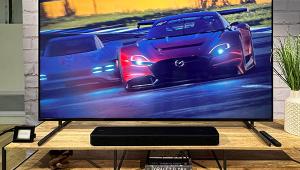Should You Get an LCD or Plasma Flat Panel?

Buying a new TV ain't what it used to bethere are a lot more choices and features to think about than yesteryear, when the only decision you needed to make was screen size. Among the most common questions I'm asked these days is, "Should I get an LCD or plasma flat-panel TV?" If you want the quick answer, jump to the end of this article. But if you want to understand the answer, read on.
Misconceptions
LCD is clearly the more popular choice these days, outselling plasmas by a goodly margin. This is due to how TVs are displayed in stores and some misconceptions about plasma longevity and "burn-in."
In retail stores, TVs are typically displayed in showrooms with lots of bright lights, and LCDs can pump out more light than plasmas can, which makes them look brighter and more attractive in that environment. But your living room or home theater is nothing like a retail showroom, so this apparent advantage is somewhat deceiving.

Many people are concerned about the longevity of plasmas, having heard rumors that the gas within the screen must be "recharged" periodically. This is completely falseplasma TVs have never required "recharging." Today's plasmas and LCDs have about the same expected lifespanaround 60,000 hours, which translates to over 20 years of watching TV eight hours a day, seven days a week.
Then there's the issue of plasma "burn-in," which causes ghostly images to remain on the screen after a static picture has been displayed for some period of time. This used to be a problem with early generations of plasmas, but it is almost no concern today. Yes, static images can be retained after a time, especially when the set is new, but it is rarely permanent, and it can be combated using one of several different techniques that most plasma TVs provide.
One thing to be aware of is the set's power consumption. Plasmas tend to consume more power than comparably sized LCDs, though manufacturers are narrowing that gap in modern designs. Interestingly, plasmas draw more or less power depending on the overall brightness of the image at any given moment.
By contrast, LCDs draw relatively constant power. And if you decrease the brightness of an LCD's backlightwhich is usually advisable in a dark roomyou can save even more power.
So, what are the real issues you need to consider in making this important decision? Ask yourself the following questions:
What will I be watching mostly?
If you're a serious movie watcher, I generally recommend plasma for its lower black level and higher contrast, which makes the picture "pop" more than most LCDs illuminated by a CCFL (cold-cathode fluorescent) backlight. However, more and more LCD TVs today use LEDs (light-emitting diodes) instead of CCFLs for the light source, and these sets can achieve very deep blackswith a few caveats.
There are two types of LED-illuminated LCD TVsbacklit and edgelit. As these terms imply, LED-backlit sets have LEDs in an array behind the LCD panel itself, while LED-edgelit models have LEDs at the edges of the screen, and their light is diffused and directed through the LCD panel using special optical materials.

Virtually all LED-backlit models provide a feature called local dimming, which brightens the LEDs behind bright areas of the image and dims the ones behind dark areas, essentially forming a very low-resolution, black-and-white version of the image as shown above. This greatly increases the perceived contrast and depth of blacks, but small, bright objects on a dark backgroundsuch as stars in outer spacecan be surrounded by halos, because the size of the independently dimmable LED "zones" is often much larger than the size of the bright objects.

Just like CCFL sets, LED-edgelit LCD TVs such as the Sony NX810 seen here can brighten and darken the entire screen dynamically, resulting in better blacks and contrast overall. In fact, LEDs can be dimmed farther than CCFLs, and they can be turned off completely if the entire image is solid black, such as the interstitial black screens between the opening shots in Cars or the title screens in Master and Commander. However, you can often see this process in action, which can be distracting.
Another problem with virtually all LED-edgelit LCDs is uneven lighting in dark scenes, which is referred to as poor screen uniformity. Some portions of the screenespecially the corners and sides where the LEDs are locatedlook lighter than other portions when displaying dark scenes. This is also evident in black letterbox bars when watching widescreen movies.
If you plan to play lots of video games on your new flat panel, LCD is probably the way to go. Video games have many static elements (score boxes, unmoving scenes, etc.) that can leave ghost images on plasmas, especially when they're new. The same goes for some TV shows, especially news and business channels with a ticker running across the bottom of the screen.
The problem is compounded if you watch a lot of 4:3 TV or 2.35:1 moviesan outline of the 4:3 or 2.35:1 window can appear on the screen after a while. Many plasmas provide a "wipe" function that floods the screen with white to exorcize these ghosts, but the longer they remain on the screen, the harder it is to completely erase them. As I mentioned earlier, new models are much better about this, but it is a concern that LCDs do not share for the most part, though some can exhibit slight image retention.




















































